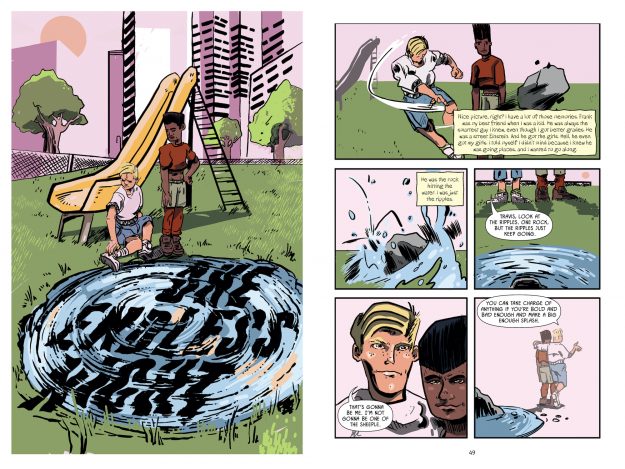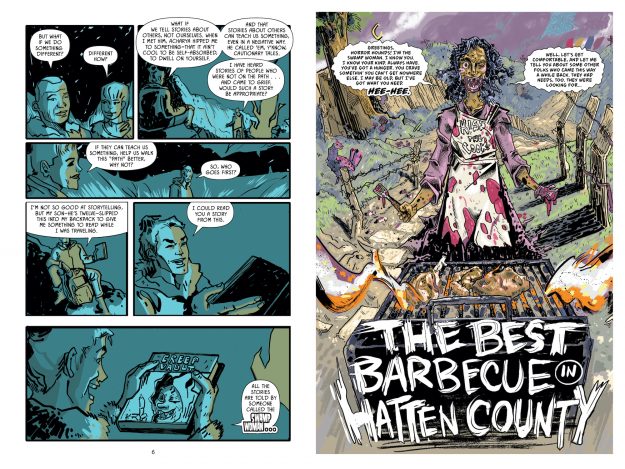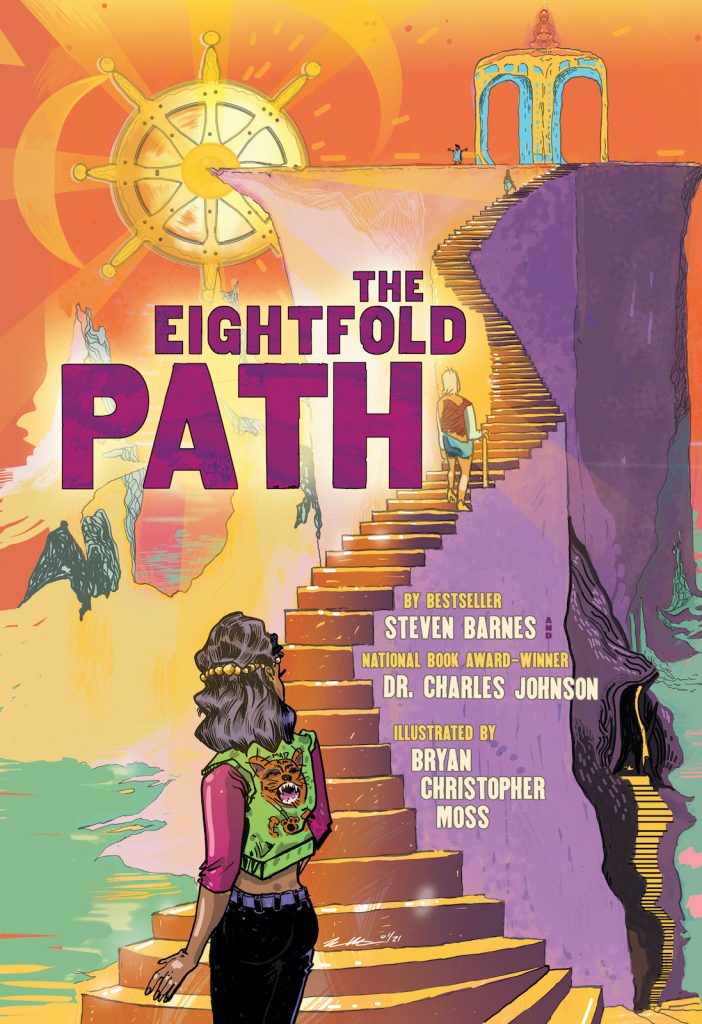“You are all here because you wish to be free,” announces a man holding a tray bearing six cups and a teapot to a few weary travelers whom he greets at the mouth of a cave. “Truly free,” he continues. “And to take the next important step in your evolution.” The meeting place is apparently a mere pit stop on the Eightfold Path—the Buddhist trajectory for realizing enlightenment, as well as the title of the graphic collection of horror stories illustrated by Bryan Christopher Moss, and written by Steven Barnes and Dr. Charles Johnson.
The tea is to be served as part of a ceremony to facilitate the death of the ego and of illusion. A tall order. It is an endeavor the nameless host insists calls for the ones gathered to tell each other stories—cautionary tales, their host suggests, which may help illustrate the dangers of not walking the path. Just as the Eightfold Path in the graphic novel is physical, so is the campfire the wayfarers huddle around, as they take turns spinning Afrofuturist yarns that, according to its authors, were inspired by the comic horror series Tales from the Crypt. There are eight stories collected in The Eightfold Path; yet, just as the steps of the path are often practiced simultaneously, many of the dramatic elements of the graphic horror tales do not reflect morals that elucidate one particular stepping stone.

At least one tall tale, however, is fairly straightforward in that regard. The second story in the collection, “The Last Word,” seems to take as its chief inspiration the vow to only engage in right speech. As with most Buddhist precepts, it is much more difficult to define what it is than what it is not, ergo the cautionary tales. For the sake of simplicity, perhaps imagine that right speech is the opposite of most of what happens on Twitter.
So, in “The Last Word,” an ambitious translator is summoned to some sort of high-security military facility to see if she can make sense of the inscrutable (to the military personnel) ramblings of a farmer who was the first to come into contact with an extraterrestrial being whose spaceship crashed on his property. Through a series of startling events, the translator—who also happens to be a Soka Gakkai Buddhist—determines that the indecipherable language the farmer speaks is, in itself, a kind of non-corporeal life form, “a parasitic meme, a . . . linguistic virus.”
In contemplating that language is a sentient being, the character animates the significance of speech, not as some transient and ephemeral non-entity lacking the capacity for the kind of harm inflicted by sticks and stones, but rather, as something that could infect and corrupt the mind like a pathogen. Also, despite the translator’s Buddhist practice, she covets the Nobel accolades her fellow workers at the Department of Homeland Security have received. This display of envy certainly doesn’t reflect right thought. Whether consulting for the DHS exemplifies right livelihood will be left to the reader to decide.
This story, more or less, typifies the tenor of the remaining Afrofuturist tales in The Eightfold Path—which also encompass the remaining precepts of right understanding, right action, right effort, right mindfulness, and right concentration. In one narrated by a wisecracking corpse, itself an homage to the cryptkeeper in the comic Tales, a woman absconds with her husband’s employee to carry on their affair in a mysterious bed and breakfast, an erstwhile plantation formerly staffed by an enslaved medicine man. In another, featuring time travel, a young black man contends with the Trump-like ascent of his white best friend and former partner in crime, who rises to head of state on the basis of promises to “restore America.” In yet another, a pair of lovers compensate for a rather bland, restless, Brave-New-World-esque existence set in the year 4189 with the petit morts of orgasmic ecstasy—that is, until they enter into a suicide pact they intend to fulfill at a covert death brothel. And, in yet another, a character takes on a dangerous mission to retrieve the truth about a contagious virus that has unleashed a zombie apocalypse, in accordance with which the “bitten” can only stay human as long as they are awake.

Throughout, the characters of the tales told by path travelers intimate their own brushes with Buddhist teachings and/or, through their actions, demonstrate the hazards of failing to do so. And all of this generally takes place in sci-fi landscapes that are as fantastical as they are familiar. Moreover, with the emphasis on horror, all of the tales in one way or another engage with the themes of fear and death, which also make up the raw material for any spiritual transformation. The campy blood and guts of horror, however, never promise a mundane happy ending, much less enlightenment—only the guilty pleasure of being a voyeur to dread and dismay.
To interweave Afrofuturism, horror, and Buddhist precepts is an ambitious task, a very interesting concept that, in the end, was not seamlessly expressed in the execution. All of the elements are there, of course, but do not harmonize to serve a higher expression of each story told. Further, just as there seems to have been a mismatch between the different elements of the graphic novel, it seemed as if the stories were written in full then illustrated later, reflecting a disconnect between the text and the resulting panels. All that said, The Eightfold Path could be an interesting read for fans of horror who would be open to picking up some Buddhist teachings along the way.
Thank you for subscribing to Tricycle! As a nonprofit, we depend on readers like you to keep Buddhist teachings and practices widely available.
